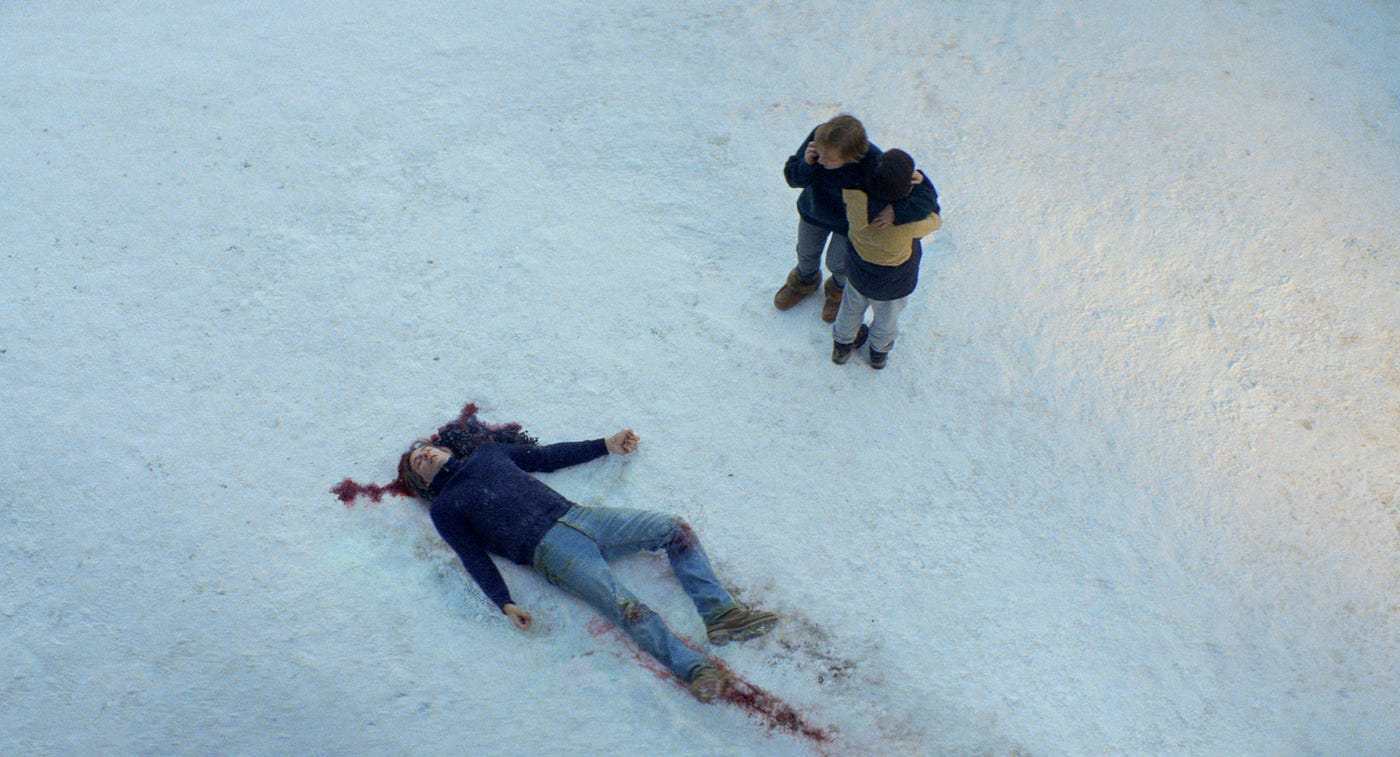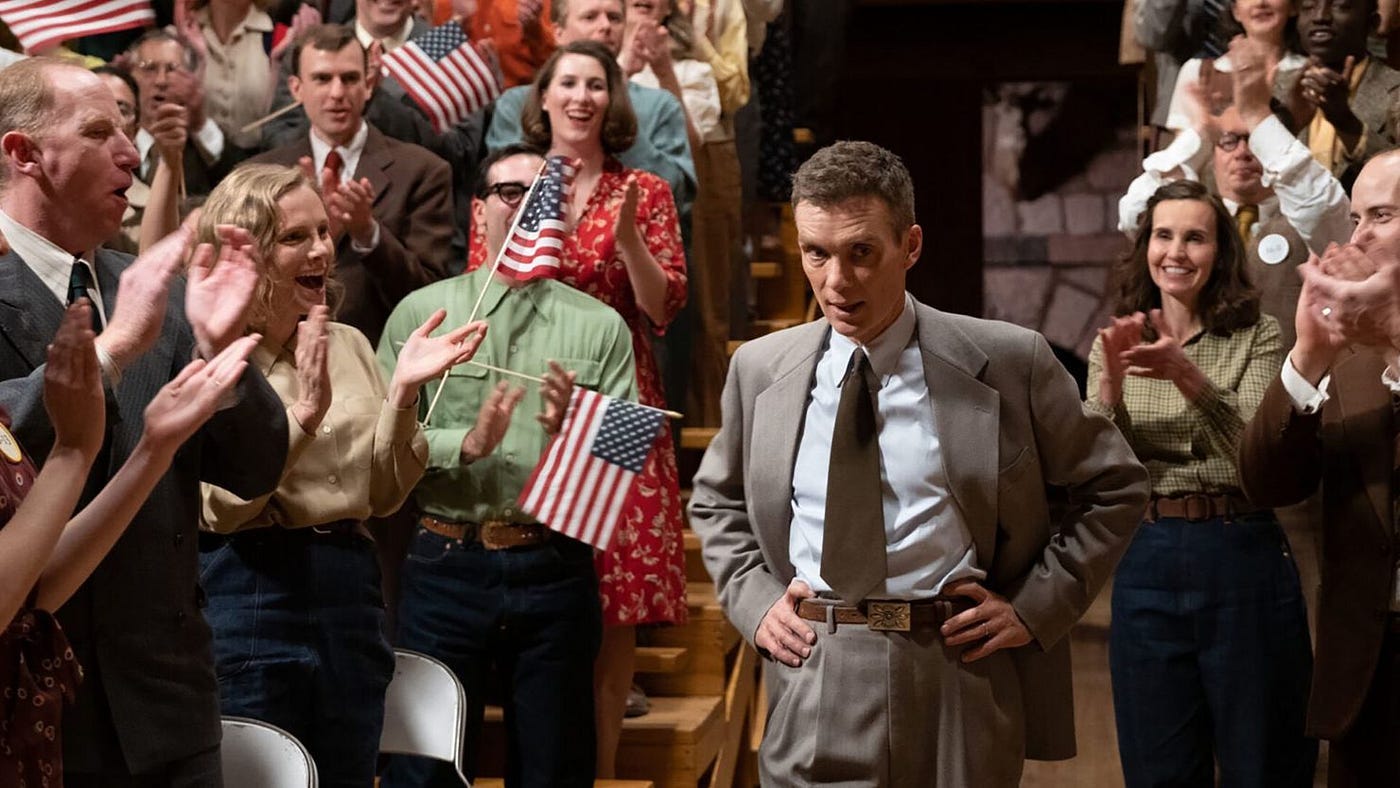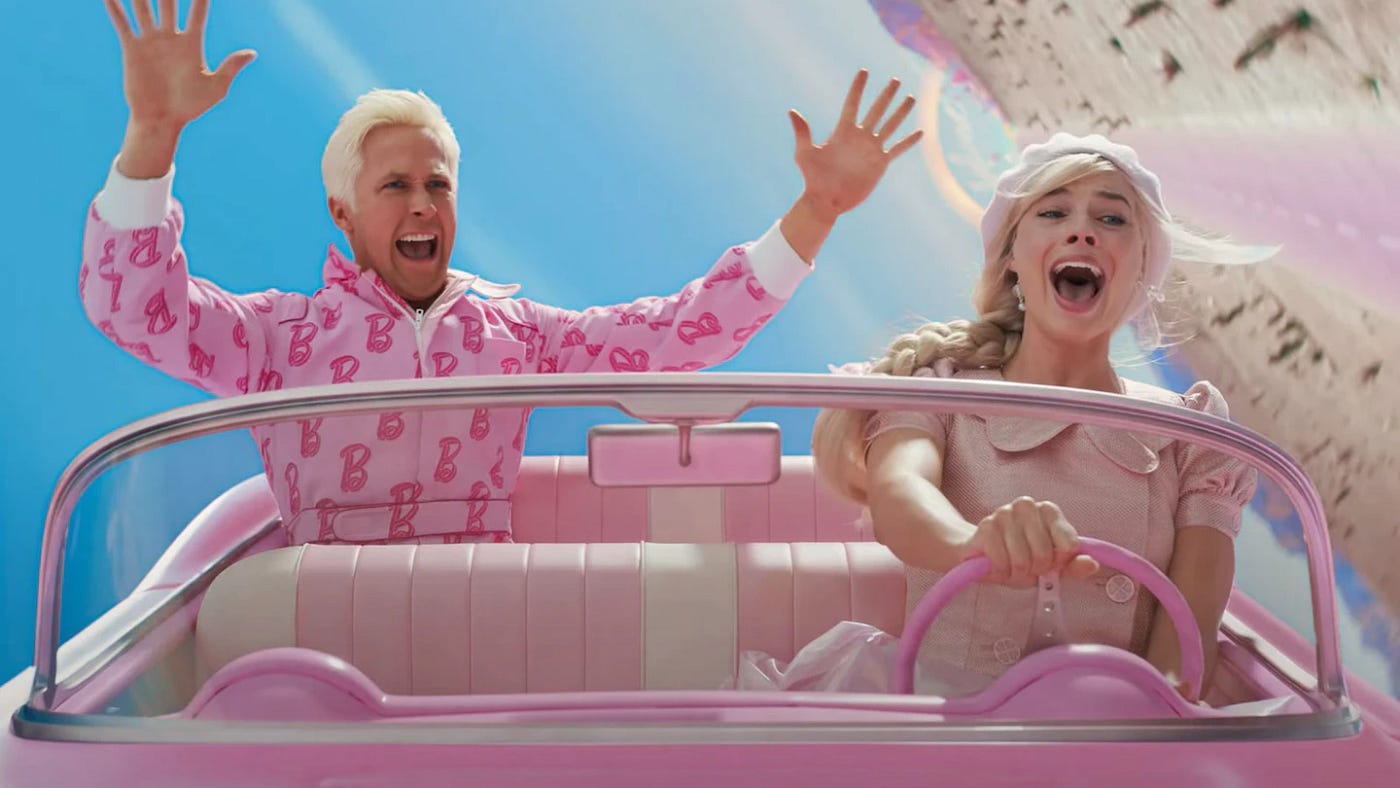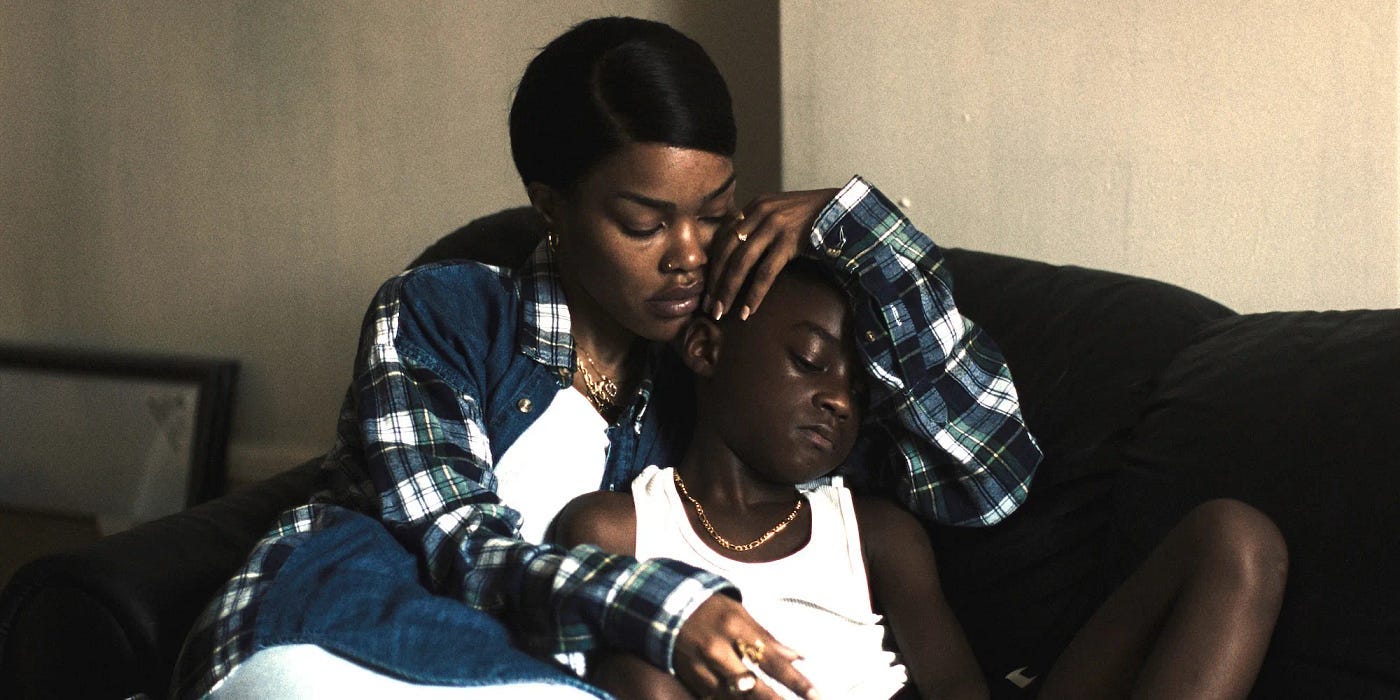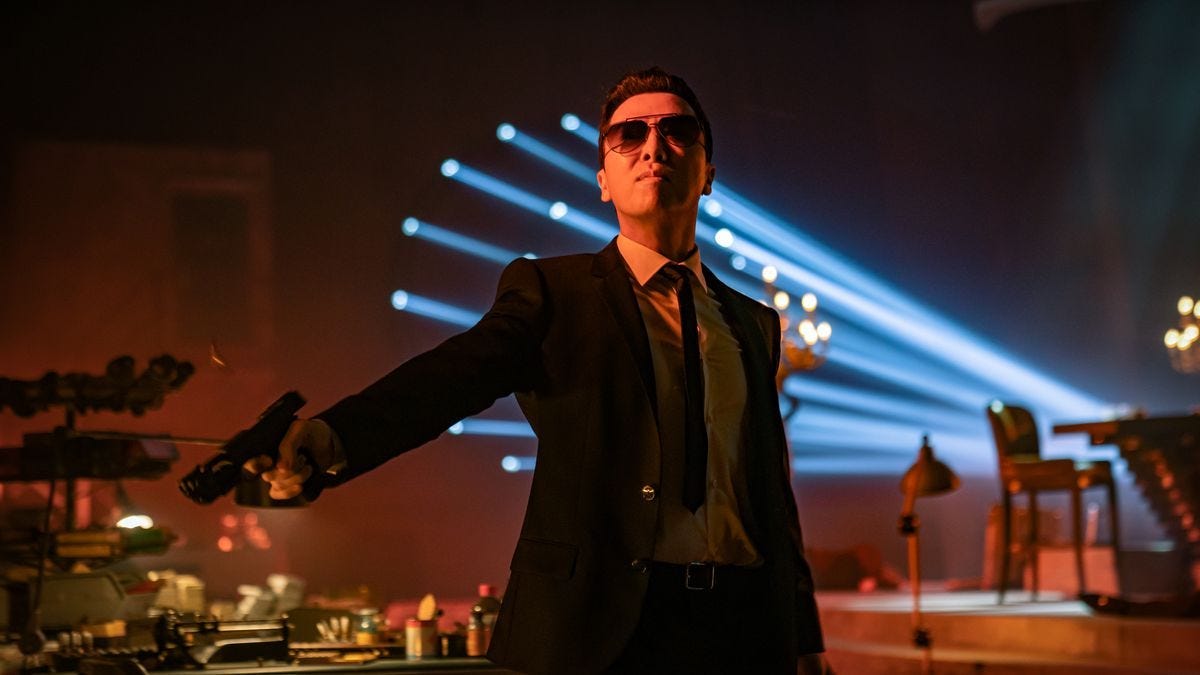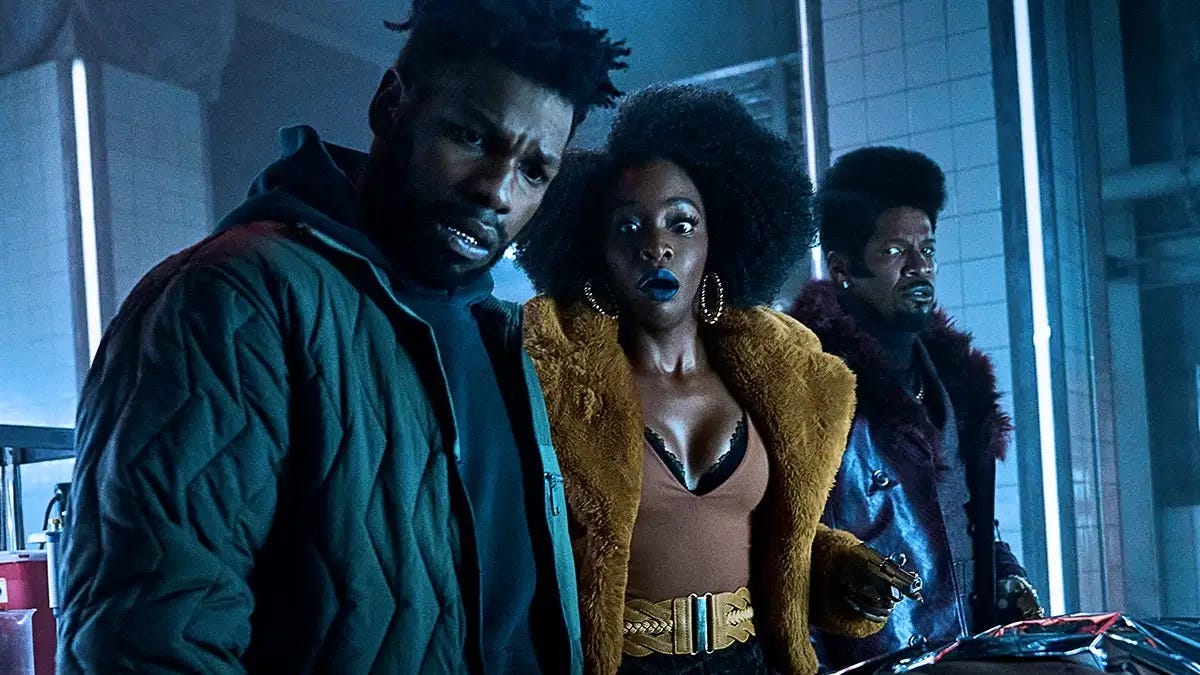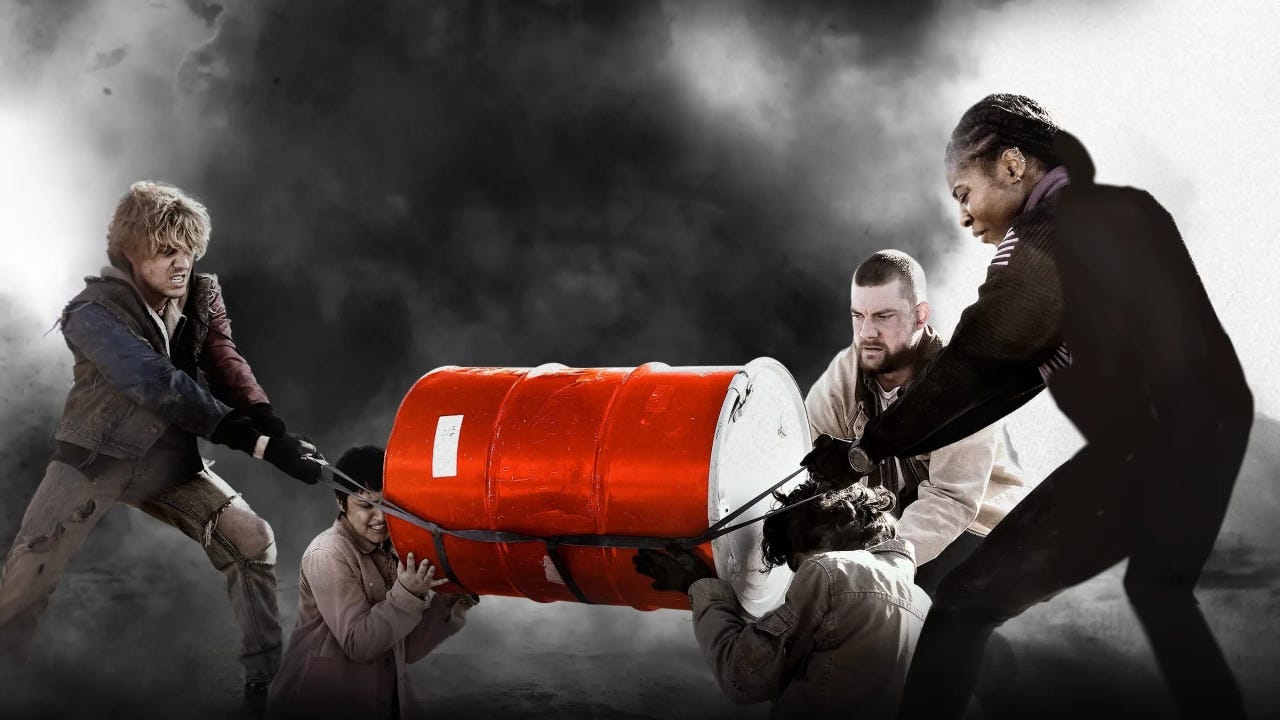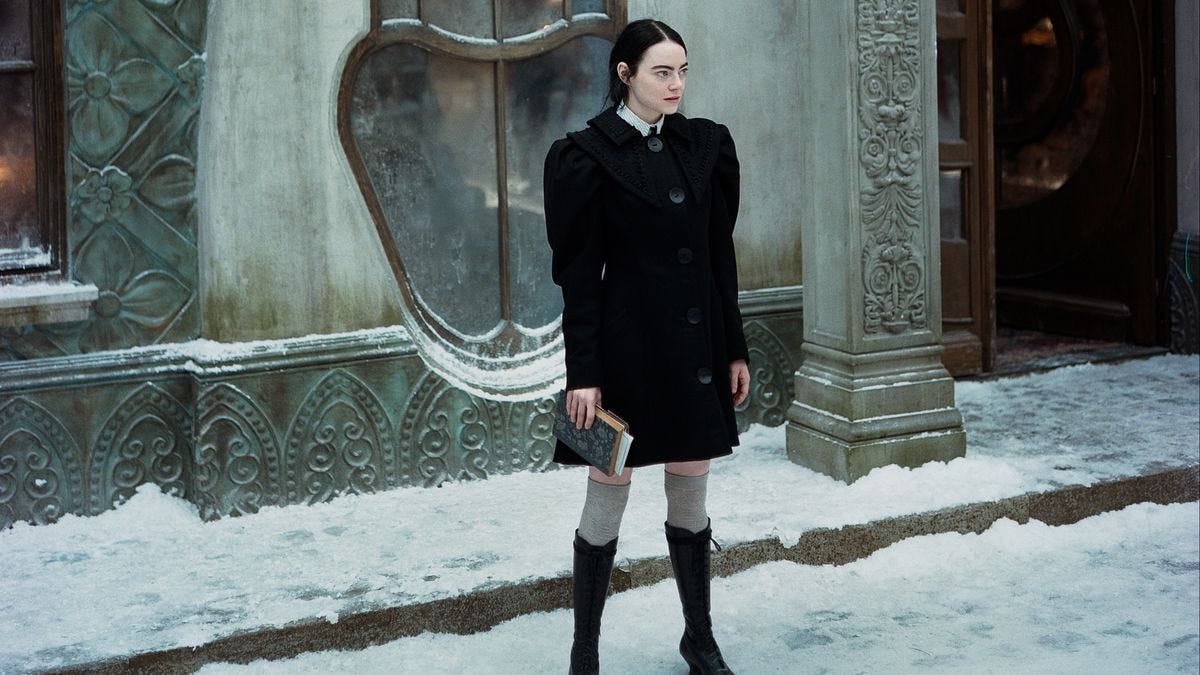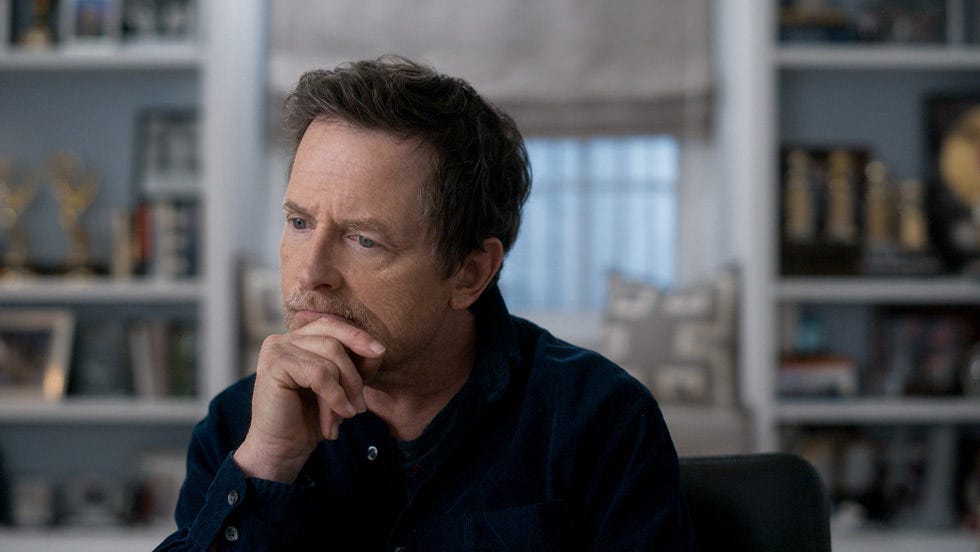Eddie’s Top 20 Movies of 2023
The movies are back!
Starting as far back as 2015, I’ve been writing in these yearly intro sections about the “Death of Movies” and the “Rise of Prestige TV”. With the proliferation of streaming services came this siren song that traditional movies were dead and that watching TV at home would be our new primary source of entertainment. The conventional wisdom became that nobody wanted to go to the movies anymore, and that even our best writers and directors would abandon the sinking ship of theaters for the fresh waters of Netflix, Hulu, HBO Max, Peacock, Paramount… TUBI? Qibbi?
As Silicon Valley threw endless cash at creatives to lure them to their streamer of choice, Hollywood was going through a bit of a rut as well. Marvel Studios began to hog all the box office for itself, and there became a feeling that you only went to the movies to see a superhero movie or a low-budget horror movie. Grown-ups would instead stay home to binge watch. The COVID pandemic felt like the final nail in the coffin. The studios gave in, launching many of their movies in theaters and streaming sites often within weeks of each other. But a handful of filmmakers remained defiant, believing that the right stories would bring audiences back to theaters. First Tom Cruise with Top Gun: Maverick, and then in 2023…
Barbenheimer.
As it turns out, audiences were just starved for fresh stories from our best storytellers. No more endless sequels of Ant-Mans and Doctors Strange. Less CGI action climaxes with actors standing on drab green screens. The three highest grossing movies of 2023 weren’t sequels or remakes. They were new, bold stories from premier auteurs. I can’t think of anything more heartening.
No, movies haven’t overtaken streaming television as our primary method of consuming stories, and with the fractured nature of how we consume media at home now, there’s probably no chance they ever will. But outside of a few Netflix breakout hits, what 2023 showed me was that the right movies can still find their way to bring back a sense of “monoculture”: the sense that we’re all watching something together again. That our culture is all experiencing something at the same time.
It’s been a truly great year for movies. Big movies, small indies, medium-sized surprises. There were so many success stories this year that I’m more optimistic about my favorite medium than I’ve been in years. Certainly, there’s a chance 2024 might not be as great, thanks in no small part to the Actor and Writers Strikes of 2023, but regardless, there’s hope. Hope that we might leave our homes and spend a few hours in a dark room with one another to try and feel something again. To be moved by a story we’ve never seen before on a big, bright screen.
At least, that’s what I hope.
I also hope that you have a great 2024, and that you maybe check out some of the movies below. They gave me so much joy, and I hope they do the same for you.
***
These are my Top Movies of 2023. As always, this isn’t an objective ranking of quality. Art is largely subjective and personal. These are just the movies that affected me most in 2023.
Past Lives
I genuinely think that Past Lives is pretty much perfect. It’s the kind of lightning in a bottle movie where every choice feels like the correct one. That it is a directorial debut from Celine Song is staggering. The performances are exquisite. The camera always seems to be in the right place at the right time, and the script feels so poetic that its ideas and themes feel as expansive and endless as the ocean.
In part, it’s a love story between two childhood friends, Nora Moon and Hae Sung. We watch as life pushes them together and pulls them apart over and over like the tide. Their friendship and potential romance feel eternal but always just out of reach, both for them and us. When adulthood finally rears its head, we watch as they are forced to begin lives separately. When Hae Sung tries to reconnect with Nora, he learns that she lives with Arthur, her new husband.
If the first half of the movie is a romance, then the second half of the movie is a ballad. It has the three characters engage in some of the most rich conversation I’ve heard in years. Conversations on what it means to lose someone, to try and figure out who you are without them, to wonder if our lives were always building toward each other, or perhaps still are? Their conversations include references to the past and future, both their lives and maybe their lives to come.
The emotions that Past Lives gave me were so vast and deep. There’s a fullness to love that can be overwhelming. The ways it enriches, hurts and gives longing. The finale of Past Lives has Nora staring into that fullness of love and finally succumbing to it through tears. Sometimes life, love and time are just bigger than what we can comprehend, but they’re also the things that embody the fullness of who we are.
Past Lives is my movie of the year because it feels eternal in a way that only the best love stories can. The kinds of stories that feel like they’ve always been with us and will carry us from this life into whatever is next.
2. Anatomy of a Fall
Think of the worst argument you’ve ever had with your partner or someone you love. Maybe it was so heated and charged that you said something truly hurtful that you immediately wished could be unsaid. Now imagine that that argument had secretly been recorded and all of the world would get to sit in judgment of what was said that day and make conclusions on your relationship. What would that outside observer think of you on your worst day? Would you seem like a monster? A sociopath? An unfeeling narcissist?
This scenario happens in Anatomy of a Fall, only the next day Samuel, a husband, is found dead in the snow. The movie then takes the shape of a crime and court procedural to investigate whether or not Sandra, a successful author, murdered her husband while their partially blind son Daniel stands as the lone witness to the crime.
Anatomy of a Fall is my favorite script of the year not because it’s an engrossing murder mystery, which it also is, but rather because it’s an investigation into a marriage. As the court proceedings unfold, we get a deeper understanding of Sandra and Samuel’s history. But while we sit and judge whether or not Sandra is capable of murder, the movie pokes back at us. Who are we to try and understand the totality of a relationship based on one weekend? How can we begin to understand the messiness that is domestic partnership based on hearsay or hidden recordings or fuzzy memories of past trauma?
Actor Sandra Huller gives my favorite performance of the year in a movie designed to have you and your partner argue about it as soon as the credits roll. Is every marriage a chaos that only those within it understand? How are our worst selves and our best selves the same people? What about our past selves and the new selves we try to form by building a life together? How do any of us survive this?
Wonderful performances, deft direction and even a standout dog actor make this a candidate for best movie of the year.
But Sarah, if you’re reading this, I’m not talking about us, babe. We’re perfect and our marriage is perfect and I already started that load of laundry and I’ll take out the trash as soon as I finish this paragraph. Promise. Love you! xoxo
3. May December
The ultimate goal of directing is about managing tone. Balancing the tone of each scene to communicate an emotion to an audience is what every director strives for. In that sense, it’s hard to think of a better directed movie from last year than May December. Director Todd Haynes balances essentially three movies at once.
On the first level, we have an often hilarious melodrama where Julianne Moore plays Gracie, a woman who groomed Joe, her child victim-turned-trapped husband and is in such denial of who she is that her opening scene has her staring deep into the refrigerator, unable to move for fear of having to confront her crimes. The camera dramatically zooms in, the music swells with a motif fit for a made-for-TV drama before Gracie exclaims “We don’t have enough hot dogs”, followed by an immediate cut to a grill with more hot dogs than anyone could ever eat. Haynes gives us a sensationalized depiction of a crime that is fit for a grocery store tabloid.
The second level is a searing satire into the limits of dramatic adaptation, starring Natalie Portman as Elizabeth, an actress hoping to portray Gracie in a filmed adaptation. Elizabeth begins to worm her way into Gracie’s life in an attempt to find the truth of who Gracie is, often overstepping the line of what is appropriate or necessary in order to get into character. On this level, Haynes appears to be asking two questions. First, is the concept of method acting exploiting its subject? Elizabeth’s endeavor to “embody” Gracie goes to such levels that can only be seen as taking advantage of the real victims left, all in order to serve her movie audience. Second, can performers ever hope to actually achieve “Truth”? Truth is what every actor strives for. The truth of what a character wants in a given scene. The movie’s finale has Elizabeth on set trying to mine that truth over and over, seemingly all in vain.
But the only truth lies in the third level: Joe, played by actor Charles Melton in one of the best performances of the year. Melton’s Joe isn’t in a melodrama or a satire. He’s stuck in a horror movie. Joe, whose childhood was robbed from him, plays the first half of the movie with such restraint that one wonders if he feels anything about his life. But slowly Melton shows the deep inner core of Joe and all of his pain. As Gracie crumbles and Elizabeth probes, Joe’s already fragile world begins to shake until there’s nothing left. It’s a heartbreaking performance and the core of the film.
May December is nimble, delicious, sharp and crushing. What a movie.
4. Rye Lane
Everything about Rye Lane is exciting. It’s bursting with youthful energy, proudly announcing a new directing talent in Raine Allen-Miller. Its visual language uses normally discomforting fish eye lenses to beautifully capture a specific London neighborhood with care. Its two leads are winning and show genuine chemistry. David Jonsson as Dom is immediately likable and Vivian Oparah as Yas is an infectious ball of manic energy.
Rye Lane is a perfect modern example of why rom-coms are just the best genre. In only 82 minutes, we go on a full journey learning of our leads, their desires, their faults and hoping beyond hope that they end up happy. Rye Lane stands with the best of what the genre has to offer. It cleverly captures the millennial/Gen Z complexities of modern romance. It never condescends to its audience or its characters. It understands when to deploy tropes and when to surprise. And boy does it surprise with a truly amazing cameo.
I fell in love with this charming, bouncy, vibrant movie. Its honesty and creativity stuck with me all year. If you love young people learning who they are and falling in love, it’s impossible not to fall for this movie, too.
5. Oppenheimer
This might sound patronizing, but I honestly didn’t think director Christopher Nolan had a movie like this in him. At his best (Memento, The Prestige, The Dark Knight), Nolan has told stories about obessessed men but often hid behind his formalism and austere filmmaking to avoid the complexities of who those men are. Put another way, he always felt afraid to get uncomfortable. Oppenheimer feels like the first time Nolan has truly embraced getting uncomfortable.
Oppenheimer still stays within Nolan’s wheelhouse of investigating obsessed, broken men. Robert Oppenheimer is immediately clocked as a man in needing of a therapist, too afraid to confront his depression and demons. In addition to his usual bag of tricks playing with narrative structure and dueling timelines, Nolan also employs dream sequences, audio manipulation and artistic representation of character’s thoughts for the first time in his career. For a filmmaker normally so proper, this feels new and exciting.
The first half of the movie is thrilling, building the foundations of the Manhattan Project like a heist movie getting the team together. Employing Ocean’s 11 alum Matt Damon as captain of the team is perfect casting. Finding simplistic ways to communicate scientific breakthroughs to the audience keeps the race to the bomb engaging. It’s odd to call the first half of a 3 hour epic rewatchable, but that’s part of Nolan’s talent.
But it’s the back portion of the movie that is fascinating. Nolan seems to be trying to investigate just how much of Oppenheimer’s pain is based in his naïveté and how much in his own desire for self-flagellation. To call this movie exculpatory for Oppenheimer would be a gross misreading. It’s clear that Robert Oppenheimer was a deeply flawed man who often wasn’t honest with himself or others. For once, Nolan seems content to leave us with our own questions about his protagonist. Like the top spinning at the end of Inception, where we fall on our viewing of Robert Oppenheimer when the credits role is up to us. What Oppenheimer accomplished/wrought was what he debated internally until his death. It consumed him and defined him. Now, in one of the most confidently made movies of the year, that debate belongs to us.
6. Godzilla Minus One
An incredible Godzilla movie about the horrors of atomic warfare and the pain of the Japanese people after World War 2. That a movie like this would come out the same year as an Oppenheimer biopic is just…*chef’s kiss*.
From its inception, Godzilla has been a vehicle for metaphor. The original 1954 Gojira used a giant radioactive lizard as a commentary on the damage of nuclear weapons. Quickly after, Godzilla films morphed from Godzilla as a walking nuke to Godzilla as an apex predator or even Earth’s noble protector. Most recently, the 2016 film Shin Godzilla used the monster and his destruction as a metaphor for stymied bureaucracy and the need for competent decision-makers in government when faced with tragedy. All of this is to say that there is no correct interpretation of Godzilla. And even in the best movies, there’s a desire to overburden Godzilla with so much metaphor that he nearly crumbles under the weight of it.
Godzilla Minus One has numerous things to say about nuclear war, the spirit of the Japanese following their defeat in WWII and what it means to rebuild a society that was so thoroughly destroyed. That Minus One chooses to tackle all of this by focusing on its human protagonists is what makes this movie a triumph. It’s impossible not to be invested in the human struggle here against a mythical foe. Some of the destruction on display in this movie is so harrowing that you can only sit in awe of our helplessness against a creature so powerful.
But Godzilla Minus One is earnest and touching, as well. A brutal, yet sweet Godzilla movie. It sounds crazy to describe this movie that way, but it’s true. That it all works and comes together is nothing short of a miracle.
7. The Holdovers
“They don’t make movies like they use to!” Well, what if someone did make one like they use to? And what if it was good?!
Every bit of The Holdovers is designed to evoke movies of an era long gone. Even though it’s shot on digital cameras, it uses numerous tricks to set us back in the feeling of films of the 1970s. Artificial film grain, an extremely tall 1.66:1 aspect ratio, a mono sound mix. Not all of this feels entirely natural, but the sentiment is there. Yet, the real homage isn’t in form but in substance. It’s the story and characters that make this film feel like the movies of old.
The Holdovers’ premise is simple. Paul Giamatti plays a grumpy old teacher who has to stay over Christmas break with a moody teenage student, played by Dominic Sessa. Maybe the student will melt the teacher’s cold heart and maybe the student will learn something about what it means to be an adult? We know these archetypes and stories, but why does watching this movie feel like slipping under the warmest blanket?
Da’Vine Joy Randolph gives a phenomenal performance as Mary, the school cook tasked with feeding the men over the holiday break. Her performance anchors the film and gives it a depth it would be lacking without. Giamatti is in full control of his curmudgeon-ness, never hitting a wrong note.
The movie is set in New England in January, and I watched it in the middle of a brutal cold January here as well. But despite the down jackets and numerous blankets, The Holdovers is the warmest film of the year.
8. Barbie
When it was first announced that Greta Gerwig would direct a Barbie movie, I admit I was deeply nervous. My adoration of Gerwig is well documented. I’ve long called Frances Ha one of the best films of the century and one that was deeply important to forming my own taste in movies. Her follow-up Mistress America felt written for me in the exact right moment of my life. When she made the jump to the director’s chair, she immediately showed why she was such an important talent with Lady Bird and Little Women. But then why was I so nervous that she was making a Barbie movie with an all star cast like Margot Robbie and Ryan Gosling?
I guess, I never imagined that Gerwig and Robbie would be allowed to make a movie this bold and sharp about of a product like Barbie. Oh Eddie of little faith.
I’m not sure what there is for me to add to the conversation about the movie of the year. Top notch performances, wondrous production design, catchy songs. There is just about nothing in this movie that doesn’t work. I have lots of thoughts on this movie’s handling of identity, but to voice them as a man would make me more of a Ken than an Allan. And us men should all clearly strive to be Allans.
To take a movie about a toy and use it to make a larger point that so many women needed to hear was laudable. But I keep coming back to the finale in that white room. Gerwig and company chose not to just make a movie about womanhood and maturity but chose to confront mortality and death. Barbie has to make a choice: does she want to be human and all that entails? To embrace our suffering and condemnation to eventually leave this world behind? And on top of that, to not just choose to be a human, but to live life as a woman and all of the unjust pain that comes with? Barbie boldly says yes, and the ending punchline punctuates that choice.
But to put that conversation about death and what it means to be human in a movie this colorful, this hilarious, this mass-appealing is nothing short of courageous. Downright heroic filmmaking and storytelling. I’m sorry I ever doubted you, Greta Gerwig.
9. Spider-Man: Across the Spider-Verse
I’ve read over 1,000 Spider-Man comics in my life. I’m by no means a Spider-Man expert, but I do think I have a good handle on who the character is. With each new iteration, you see the same beats happen. Precocious teen gets powers, loses a loved one and has to learn to balance power and responsibility. It’s a tale that even a Spidey-amateur knows all too well. What Across the Spider-Verse dares to ask is if those recurring beats are more important to Spider-Man or to us?
With each new Spider-character introduced, there is an accompanying visual flair, each more inventive than the last. At times, Across feels overwhelming in its visual splendor, like your brain is constantly just trying to keep up with images it never thought possible. Yet despite new animation styles for each new hero, Across reminds us that the Spider-Man in each story has to stay the same. You can be the most outside the box Spider-person in design, but we as an audience must experience the same story points over and over or it all crumbles. Unless….
Across the Spider-Verse is only half a movie, but the finale it sets up appears to be tackling fandom itself. Maybe we can allow these comic book characters to grow and change instead of being stuck in a prison of tropes and formulas. Maybe Spider-Man will prove that the things that make him Spider-Man aren’t our familiarity with who we think he is, but rather all the things we know he can be and represent. Or maybe not. We still have to see how this ends, and your guess is as good as mine.
10. A Thousand and One
A Thousand and One is about a woman named Inez recently released from prison who decides to “steal” her son Terry out of foster care and build the life she’s always dreamed of. The film is set in New York City through the 90s and 00s, with each chapter punctuated by the political backdrop of NYC’s mayor at those given periods. It’s a fascinating snapshot of NYC, contrasting the personal story of Inez and Terry with the greater sentiment of a city constantly amidst change.
The film is gorgeous, with deep colors and a verisimilitude unrivaled by any movie this year. Teyana Taylor’s performance as Inez is wrenching, and each Terry actor throughout the years gives new dynamics to their relationship. A.V. Rockwell appears to be a young filmmaker to watch. If she’s able to lend this much texture and feeling into a debut, it’s exciting to think about what might be to come in the future.
11. Killers of the Flower Moon
At the end of The Wolf of Wall Street, a 3 hour epic of debauchery and excess, director Martin Scorsese has conman Jordan Belfort ask the audience if they’re ready to follow in his footsteps. The camera pans behind the back of the audience mirroring the crowd watching in the theater, effectively asking us if we’re complicit. His most recent movies, Silence and The Irishman, end with indirect questions on whether or not Scorsese’s faith and sin is worthy of redemption. At the end of Killers of the Flower Moon, another 3 hour epic, Scorsese inserts himself into the narrative posing another similar question: Are we all complicit in the glorification of genocide as we watch these true stories of pain and suffering?
On a technical level, Killers of the Flower Moon is impeccable. Scorsese’s formalism is on complete display, with clearly a titanic budget and performances to match. Leonardo DiCaprio subverts his typical heroic protagonist persona to play a man in search of a conscience. Robert DeNiro can play a villain in his sleep, but his character here uses his villainy against the Osage in subtle, conniving fashion. The entire movie is also filled with local Osage non-actors who lend a humble gravity to the film. But newcomer Lily Gladstone is the beating heart of the movie, and her performance is one of glorious restraint.
While I have complaints and reservations in how Flower Moon deploys Gladstone’s Mollie, I think that Scorsese’s goals echo those reservations. At times Mollie is outwardly silent when it’s clear she’s inwardly raging. Early on, DeNiro’s William Hale informs us that “the Osage are quiet, but they see everything”. Mollie appears to be a woman who understands the brutality around her, but feels unable to stop it. In the end, when confronting her weak husband about the violence inflicted, he demures. She already knows the truth but wants to hear it herself.
I don’t think Killers of the Flower Moon stands as strong as Scorsese’s recent films because those were so clearly about his own convictions. Flower Moonis not Scorsese’s story, and it’s clear he’s wrestling with that fact. The fact that America’s oppression is his guilt, but the Osage pain is not his pain. In any other filmmaker’s hands, perhaps this movie wouldn’t work. But Scorsese’s relationship to filmed violence and suffering is unmatched. So when one of our greatest filmmakers makes a complicated question mark of a film like this, I think it’s worth ruminating on that question for a little while.
12. Theater Camp
Listen, if you didn’t grow up in a theater or around theater kids, then this hilarious mockumentary won’t do anything for you, but I was dying from the first five minutes. I don’t think I laughed harder at a movie this year.
Ben Platt and Molly Gordon play Amos and Rebecca-Diane, two childhood friends turned camp counselors who have to save their dying theater camp after its founder lands in a coma. Will this movie end with One Big Show to try and save the summer camp??? Of course it will, but watching it stumble into form is part of the joy. Platt levies his big Broadway energy to play the overdramatic acting coach trying to teach precocious child actors how to mine their souls for dramatic tears. Molly Gordon, who also has a directing credit, is quickly building quite a career for herself with pitch perfect performances in this and recently Shiva Baby.
When the cast sings the final number of their summer showcase, I couldn’t contain myself. I deeply love this silly, over-the-top movie. Maybe it’s because I love laughing at the theater kids I grew up around. Maybe it’s laughter of embarrassment at my own history as a self-aggrandizing theater kid. I don’t know. I just know that I couldn't stop laughing at this heartfelt movie that maybe hit too close to home.
13. John Wick: Chapter 4
There’s a scene early in John Wick: Chapter 4 where Donnie Yen, playing a blind assassin, stumbles through a fight in a kitchen. The John Wickfranchise has always been a circus of violence, but casting one of our greatest cinematic martial artists was a masterstroke. Watching Yen’s control of his body in this scene is breathtaking. Each moment feels simultaneously considered but also like total improv. Any time Yen is on screen, the movie elevates to a new level.
The Wick series was built on Keanu Reeves’ fierce strength of will, but at its core, the series is about stuntwork. It was created by Reeves and Chad Stahelski, his former stunt double. With each new film, the pair have upped the complexity of violence in motion. Stuntwork has long been the most underappreciated artform in Hollywood. Hopefully someday we will get an Oscar category for the amazing work stuntpeople do. Until then, we can only sit back and marvel at movies like this. There are scenes in this movie meant to make you feel astonished, applaud, laugh, recoil and sit in pure disbelief that these performers were able to accomplish them.
At its core, cinema is about objects in motion. Action, dance, blocking. It’s all core to what movies are. What legends like Charlie Chaplin and Buster Keaton pioneered. As John Wick fights his way up 222 steps in Paris only to hilariously and impressively tumble all the way back down, I’m certain that this is exactly what our founding cinematic fathers would have found absolutely rad as hell.
14. They Cloned Tyrone
Sometimes I genuinely think that Jamie Foxx is the most talented man in Hollywood. He’s a world class dramatic actor, an insanely talented impressionist, and just downright hilarious. They Cloned Tyrone is one of the most purely fun movies of the year thanks to the glorious combination of Foxx, John Boyega and Teyonah Parris.
Tyrone is a sci-fi comedy that walks just over the line of absurdity in all the best ways. It has solid commentary on blackness and its relationship to capitalism. The way black bodies are commoditized and disposed of. It’s got a satirical lens to its science fiction like a modern age John Carpenter movie. But it’s also got some of the quickest humor largely thanks to Foxx.
They Cloned Tyrone’s title implies a general assumption on the concept of the movie, but so much of it is surprising and the script never slows down. That mixture of cleverness and tautness makes this the easiest recommendation of the year. Watch this movie. You’ll laugh and have a blast, I promise.
15. How to Blow Up a Pipeline
The title of this movie is taken from a book of the same name and is less a “How” and more of a “Why”. How to Blow Up a Pipeline is a politically charged heist film. There’s no way to hide the fact that the movie is an endorsement of leftist violence against corporations dispassionately harming our world. If that desire for change through violent action makes you bristle, than this movie isn’t for you. As a critique, I would argue that while the movie’s conviction is firm, its sanitation of the possibility of human violence as a consequence of revolution is sidestepping an important moral debate. Thus, the movie frames political violence as infallibly moral, but to debate this further, I’d probably want to have a nuanced conversation that my word count here won’t allow.
Regardless, what’s undebatable is how a $1 million movie is more thrilling than 90% of the movies that Hollywood released this year. The tension builds in all the right moments. The cast feels locked in, and the production of the movie nails what’s serene and isolating about rural Texas. How to Blow Up a Pipeline is a manifesto, and like most manifestos it’s messy and maybe incomplete, but its conviction cannot be denied.
16. Poor Things
There’s a trope in movies called “Born Sexy Yesterday”. A character is coded on screen as a beautiful adult but has the mind/innocence of a child. The protagonist of the movie, usually a man, takes the adult child under their care as their protector. In this protection, a romance eventually forms where the adult child sees their guardian as their first example of a noble hero. The adult, no matter how mediocre or normal, gets to appear as miraculous to the adult child. As one might imagine, this is very much problematic if not entirely gross. There are numerous examples throughout the years: The Fifth Element, Splash, Enchanted, The Little Mermaid, Tron Legacy.
Poor Things stars Emma Stone as Bella, a grown woman with the mind of a child for reasons I won’t spoil. What starts as an example of Born Sexy Yesterday becomes a subversion of this trope as Bella quickly begins to mature. As she comes into her own mental adulthood, she uses that previous naïveté to the world around her as a scalpel to investigate the flaws in our society. She begins to see the men who once clearly desired to own her womanhood now as obstacles standing in her way. In some of the boldest imagery of the year, Bella begins to own her body, her sexuality and her own mind.
Director Yorgos Lanthimos has always played in the realm of discomfort and provocation. Poor Things is no different, set in a heightened reality of science, sex and vulgarity. Lanthimos uses that elevation to achieve stunning visuals and hilarious, off-kilter performances from Stone and Mark Ruffalo. It’s a movie decidedly devoid of filter or shame, and just like Bella, it’s all the freer for it.
17. Are You There, God? It’s Me, Margaret.
In 2016, director Kelly Fremon Craig made The Edge of Seventeen, a modern coming-of-age classic. Making her follow-up an adaptation of a beloved novel in the same genre seemed like a slam dunk. And, as it turns out, it was.
I truly believe that Rachel McAdams is one of our greatest current actresses. Her ability to play drama, romance and comedy with aplomb is remarkable. The fact that she so gracefully and deftly transitioned from young ingenue roles to now sweet, maternal roles like the young mom here is just another testament to her talent.
As a young male who spent most of his time thinking about Pokémon and Spider-Man, I sadly never read the original novel this movie is based on, but any time I asked a female friend about it, they instantly would say, “Oh yeah, of course I read that. It was super important to me”. Without that knowledge base, I’m sure this movie didn’t hit me as hard as it might hit some, but I’m such a sucker for all coming-of-age movies. I’ve said before that I think coming-of-age stories are the purest genre of storytelling with character growth built into the foundation of every script. There’s a universality to movies like this. Even though I never struggled with needing my first training bra or my first tampon, I did experience a childhood. I felt joy, shame, rebellion and burgeoning wisdom just like Margaret. It doesn’t matter who you are, this movie is for you, too.
18. Asteroid City
Augie: “I still don’t understand the play.”
Shubert: “Doesn’t matter. Just keep telling the story.”
Director Wes Anderson’s style is so distinct that any time a trailer is released, most of the audience has already made up their mind if his movies are for them. Anderson is aware of his “schtick”, but Asteroid City is his firmest answer yet that he doesn’t give a damn what you think. He has to make his movie like this because it’s the only way he knows how.
Much like last year’s The Fablemans, Asteroid City is about an artist trying to explain why they are compelled to create. There’s so many narrative layers to Asteroid City that at times it feels purposefully elusive. It’s got Anderson’s usual dry wit and endless A-list casting, yet in recent years his narratives have only gotten more meta. I’d argue that his recent work, while maybe not his best, is certainly his most mature and thematically complex.
Augie is a photographer played by long-time Wes Anderson vet Jason Schwartzman. He also plays “Augie” the actor playing Augie the photographer. It’s confusing, but what’s not confusing is the ending. Searching for meaning of why he must take his photos a certain way or why he must play his character a certain way, Augie has a conversation with his former screen partner. She says, “I’m not coming back, Augie. Then you take a picture and start crying, and I say, ‘I hope it comes out’”. Augie responds: “All my pictures come out”.
Wes Anderson makes his movies like Wes Anderson because that’s who he is. It doesn’t matter how or why, all that matters is his movies come out. His art — his way to understand the world-comes out the way it does because his pictures always come out. How we respond and interpret them isn’t his problem, it’s ours.
We might not understand the movie, the story, the play but it doesn’t matter to him. He just has to keep telling the story.
19. Priscilla
Priscilla is a sister film to Poor Things and Barbie, keeping with one of the major themes of the year in the patriarchal ownership of women. Where last year’s Elvis gave us an ostentatious depiction of a gilded popstar, Priscilla shows us the gilded cage his wife was trapped in. Meeting her as a high school freshman, the imbalanced power of their relationship is there from the jump. The common refrain of “things were just different back then” can’t gloss over the level of isolation that Priscilla was subjected to as a young woman desparate to keep her celebrity partner. Last year’s Elvis showed Presley as the biggest figure alive, but Priscilla shows him as a huge loser. A man clearly lost in his own fame, his own desire to be taken seriously and his own arrested developent, keeping young Priscilla as both play-thing and safety blanket.
Copolla’s movies have always been more about capturing a mood than narrative clarity. Her profundity comes from understanding how to sit in a vibe and bring us with her. So when the back half of the movie speeds through the later chapters of the couples’ lives like a standard biopic, I feel like the movie loses some of its power. Still, none of that detracts from how perfectly lonesome the first half feels. How Copolla captures the feeling of endlessly waiting by the phone, waiting for a call that will never come.
20. Still: A Michael J. Fox Movie
I deeply love Michael J. Fox. Like so many other nerds shaped by Back to the Future, Fox’s bundle of short, manic energy spoke to me as a short, nerdy kid. While Fox’s career was full of hits and misses, it’s clear that his place in the great pop culture landscape was forever changed after announcing his Parkinson’s diagnosis. Still is a zippy documentary about how Fox himself felt about that sudden shift. While there’s nothing in this doc that wasn’t in the E True Hollywood Story retelling of his life or many tabloids, the one thing it does have that those do not is Fox himself.
The movie is told through semi-dramatizations of Fox’s life using cleverly edited performances from his past. As a child star, there are countless hours of footage, and the movie understands that the best way to embody Fox’s spirit is by only showing Fox and his gift of charisma. The doc makes the specific choice to not include any other talking head interviews besides Fox. His wife and parents are all shown, but this is Fox’s story. In each interview, you see Fox battling his disease. Whether he’s having a good day or bad day isn’t easy to see, though. His face is mostly flat throughout the doc, a tragic side effect of his illness. However, that doesn’t stop Fox. He jokes and quips as fast as ever, even when his face and body betray him.
Michael J. Fox is, was and forever will be a force of nature. He’s a flawed man with a varied career. He knows that his life will be defined by his early hits and his late tragedy, but all he seems to care about his holding on to what life and energy he has left. I think he knows we all love him, and I think this doc is his way of telling us that he loved entertaining us, too.
Honorable Mentions (alphabetical):
Air — It’s a testament to Matt Damon’s talent as an everyman that this movie works as well as it does. There’s barely a fraction of characterization of any character in this movie, but it doesn’t matter. There’s barely any relatable stakes or obstacles for our characters, but it doesn’t matter. All that matters is that when Matt Damon wants audiences to care about something, we care. And when he’s having fun, it’s so easy to have fun with him.
All of Us Strangers — Getting to talk to your dead parents is still such an effective dramatic tool and any conversation about parent-kid relationships killed me. All of the performances here are crushing, but the way it wallows in misery, especially the ending, just didn’t hit for me. Still, as soon as it ended, I immediately went to hug my son, so I guess the movie hit me in some way.
Blackberry — It’s got all of the classic trappings of a tech formation movie, like The Social Network or any of the Steve Jobs movies. A bunch of old men don’t believe that these young, hungry innovators will change the world until one day they do. Glenn Howerton is triumphant here. I’m just still not a believer in Jay Baruchel’s range, sadly.
Dungeons & Dragons: Honor Among Thieves — It makes sense that the creators of the underrated Game Night would take a movie like this and make it the surprise comedy hit of the year. We’ve long since come to the consensus that Chris Pine is the Best Chris. All I know is we deserve a sequel with this lovable cast and their infectious energy.
Fallen Leaves — A microbudget movie about a micro-romance full of micro-performances. Perhaps its the language barrier, but much of the performances felt stilted and the drama thin. But it captures what feels like a real, earnest feeling of industrial Finland.
Kokomo City — A doc following four black, trans sex workers. This is a blast as all the narrators are charismatic and often hilarious. The main critique is that, at times, it’s barely a doc and could function as a podcast since most of it is just dramatized stories. But the stories are so good that the time flies by.
M3GAN — Following the bonkers Malignant, I think it’s fair to say that producer James Wan is slowly tapping into a new avenue of horror camp. At its best, M3GAN is hilarious and breezy, but I just hope the sequel goes even further in the silliness. Follow the template Child’s Play gave us and embrace the cheese.
Mission Impossible: Dead Reckoning — The script doesn’t entirely work. The action doesn’t compare to the high watermark of MI:Fallout. But geez are all of the women Cruise is surrounding himself with total badasses. Hayley Atwell, Rebecca Ferguson, Vanessa Kirby, Pom Klementieff. Any time any of these impossibly cool women are on screen, the movie sings. Cruise has found a winning formula here.
Polite Society — A sweet movie about sisterhood and the wonder of martial arts. The sci-fi twist doesn’t entirely work for me, and I think the action is sadly flat. But I love the spirit here from all involved.
Reality — I don’t know enough to render judgment on Sidney Sweeney’s talent as an actress, but her restrained portrayal of Reality Winner in this tense mini-drama was effective on me. The movie requires a lot of informational legwork from the viewer in regards to their understanding of what happened to Winner in real life, but as a drama, it’s very tense and arresting.
Talk To Me — I think this is the first horror movie to truly capture the Snapchat generation. Anytime this movie features teens being teens, the vibes are immaculate. But I think horror’s recent obsession with making trauma underpinnings as text instead of subtext is overdone and largely unhelpful. Still, I’m curious where these filmmakers go next.
Teenage Mutant Ninja Turtles: Mutant Mayhem — We’re forever grateful that Into the Spider-Verse forced studios to embrace that audiences wanted visual inventiveness rather than the standard Pixar-school of animation. The Gen Z vibes here are great and Paul Rudd steals the show, as usual. I just wish the climax had found something more interesting and personal than a giant CGI monster battle. So for now, the 1990 Ninja Turtles movie remains at the top.
The Iron Claw — Zac Efron’s control of his body is remarkable, and it’s surprising that a movie this full of misery could be so watchable. Easy sports movie recommendation, even if the Ric Flair actor could never hope to match even an iota of the charisma of the genuine article.
The Zone of Interest — Like his previous movie Under the Skin, there’s this clinical nature to Jonathan Glazer’s films that keep the audience at an arm’s length. Making a movie about the Nazi family who live next to Auschwitz and live their normal lives while constantly hearing atrocities in the background, Glazer’s restrained filmmaking makes sense. This clerical style of filmmaking underscores the dry banality of evil, but also maybe that isn’t the most engaging movie? It’s an arthouse film for a very specific type of arthouse person. Throw some genocide on top of that, and you got a movie that’s impossible to recommend to anyone normal but impossibly haunting.





